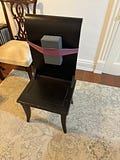Spring has nearly sprung here in NYC. The winter coats are packed up. The long walks outside can start again. And the incessant humming of the bulldozers next door remind you that rebirth is eternal…whether you want it or not!
I’ve been writing a lot about the workings of this Alexander Technique for about a year now. But I’ve skipped an extremely important topic. It’s one that I talk about with my students, but I don’t think it really hits home in a lesson the way it should. Just how much does furniture design/ergonomics factor into overall health and wellbeing?
The short answer to this question is that it matters quite a great deal. If you ask anyone… Alexander Technique teachers included… how to sit comfortably on an airplane, the answer is inevitable something along the lines of, “Ugh… You’re just f’d dude. Get an aisle seat and stand when you get a chance.”.
I could say the same for spending long hours in the car. Those seats are designed to keep you alive in the event of a crash; not encourage a great upright sit. There’s a way to sit in that car seat more comfortably, but at the end of the day you’re being served a big dish of labskaus. Try to swallow it with grace and do the best you can.
Outside of these two horror shows though, we have much more say in what we choose to sit on and how we organise our work stations. If we take the time to find ways to adapt our chairs and desks to our height (and even our particular injuries), we can make ourselves more comfortable and have a better chance of applying what we learn in an Alexander Technique lesson.
Here are my high level thoughts on how you can adapt the world to YOU. I believe that all of these adaptations can be done relatively cheaply so there’s no excuse for not trying them out.
Adapt The World To Your Height And Ability When Possible
I start with this topic because it is the rule that all other ‘ergonomic’ rules are built around. Typically, ergonomic rules are purely height based and suggest optimal viewing distances for screens and such, but this ignores the very real challenges some people have. In my case, my weak vision means that an 18’’ distance from my head to my computer screen is not always a good idea. As a result, my monitor height and distance at my computer is adjustable so that I can see my screen without needing to crane my neck and drop my head into dead weight.
Think. Adjust your workstation. See if it helps. Repeat.
Sitting In A Chair
When sitting in a chair for either typing or playing an instrument (active sitting if you will), you want to make sure you can have comfortable contact with the floor and the chair. Your feet should be able to touch the ground. Your bum should be able to rest on a flat and stable surface.
Chair Height
Your chair should be high enough that your knees are below the hips and your feet are on the ground.
Chair Back
Ideally, you should also be able to use the chair back for support if your chair has one. For long hours at an office job, you need a chair back. Not always. But often enough. Don’t be a hero.
The chair back should have zero recline. You want to be able to use the contact of the chair to know exactly where UP is.
Back Support On Chair Back
For additional back support, I tie a yoga block to the back of my chair. This is something FM Alexander did with his teaching chair.** I place the block on the mid to lower portion of the thoracic spine so that the block does not touch my shoulder blades at all. I want the back portion of the torso to have a very strong sense of the upward direction and I want the lower back to have the freedom to have a lumbar curve without locking the hips, knees, or ankles into a set place.
Chair Seat Angle
The chair should have a flat bottom or ideally it will have an angle that encourages the knees to be lower than the hips. The purpose of this is to encourage the legs to soften and release tension at the hip socket.
Many modern dining chairs have a ‘relaxed’ angle and force the knees to be higher than the hips. This is why car seats suuuuccccckkkkkkk***.
Is Your Work Chair Like This?
The answer for most of us is NOPE. Take your time to figure a solution out.
Need a taller chair? Buy some cheap bed risers!
Need a shorter chair? Put some phone books under your feet!
Need an angled chair? Buy a cheap chair wedge!
Need a back support? Grab a book and an elastic resistance band!
Need to work at a cafe but your feet don’t touch the ground? Use a portable foot rest!
My point here is not to plug these products but to encourage you to find something comfortable that helps support your back during the day.
Don’t be a hero!
Working At A Desk
If you’re a typist, you’ll have one or two computer monitors and a keyboard/mouse as your physical interface with your device. The general rule of thumb is that all of these objects should be adjusted to you so that there is absolutely zero reason to tense up the neck and drop the head/shove it about.
Keyboard Height Matters
You must find a way to type so that the wrist and elbows are free from extraneous tension. These joints should feel like effortless butter while you work. Placing the keyboard slightly above the lap is a very good idea. This is why keyboard trays exist. USE ONE.
Pretend you are a classical pianist. Watch Arthur Rubenstein perform. THAT is what you want while you type.
Computer Monitor Height And Orientation Matters
As I’ve alluded to earlier. Your monitor height should encourage you to face forward without dropping the head. I have seen students come in who twist the spine to the left or right even while away from the computer because they have placed their monitor off center and sit with a twist in the back all day. PAY ATTENTION TO WHAT YOU ARE DOING.
When it comes to your monitor distance, please bear in mind that every computer application has different sized fonts. Some applications like music and video editing software have very small knobs and sliders. I find that I need to peer at these unless I bring the monitor quite close to my face. This is why some producers use HUGE monitors to do their work.
BE COMFORTABLE. YOU ARE WORTH IT.
TAKE BREAKS
You’re going to notice as you work that you get tired and start to drop your head and cluck like a chicken at some point in a long work day.
Get up.
Take a walk.
DON’T. BE. A. HERO.
Working At A Cafe
You do it. I’ve done it. It happens. And it’s ALWAYS uncomfortable.
If you insist on doing this, please don’t do a long work session of several hours. That’ll kill ya. But if you do, please take that foot rest with you if you need it. Take an external keyboard or a laptop riser. These situations can be made more comfortable and it will help you from collapsing in the back.
To paraphrase my teacher, “There’s always a better mousetrap”.
Will You Change?
Here’s the rub. All of these changes are relatively simple to make and cheap, but they will require you to take a minute to think about how you go about your day and notice what and how you are doing things. Oftentimes, when I make these suggestions to a student they will feel “awkward” about making a public change or they will say they don’t have the time. It’s almost as if changing your desk setup and sitting differently becomes a revolutionary statement to the world.
In a sense, it very much is. It’s your way of declaring “Out with the old! In with the something else!”. People will see you doing different stuff. And if you’ve been reading my blog, you should be very comfortable with people saying, “Hey, you seem different. What’s been going on?”.
I strongly encourage you to take a gander at how you go about the simple acts of your life and ask the very simple question, “Can I be more comfortable and supported?”
** Technically, FM Alexander used a cigar box… Alexander technique is for general wellness and FM had no issue with moderate smoking and drinking.
*** That and they can restrict head mobility if you don’t have the head rest properly aligned. That reaaalllllyyy blows chunks dude.




